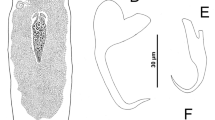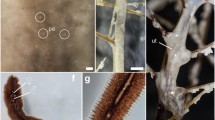Abstract
Echinoplectanum n. g. is erected for diplectanids which have a male copulatory organ comprising a tubular sclerotised penis with a muscular reservoir at its proximal extremity and an protrusible cirrus, often with spiny ridges, at its distal extremity, and a female copulatory organ comprising a sclerotised vaginal sac, often with two thin tubes. All species have similar squamodiscs made of rows of rodlets, with the central rows forming closed circles, and haptoral parts with a similar shape but different measurements; they are distinguished on the basis of the size and morphology of the male copulatory organ and sclerotised vagina. Five new species are included in Echinoplectanum and are all parasites of coralgroupers, Plectropomus spp., off New Caledonia, South Pacific. Two are from P. laevis (Lacépède): E. laeve n. sp. (type-species) has a large elongate penis, 53\(\upmu\)m in length, a cirrus with spiny ridges and a spherical vagina with two long thin tubes; and E. chauvetorum n. sp. has a large elongate penis, 51\(\upmu\)m in length, a cirrus with thin spiny ridges, and a pear-shaped vagina with two short thin tubes. Three species are from P. leopardus (Lacépède): E.␣leopardi n. sp. has an elongate penis, 36\(\upmu\)m in length, an unspiny cirrus and a triangular vagina; E.␣pudicum n. sp. has a very small elongate penis 14\(\upmu\)m in length and no visible vagina; and E. rarum n. sp. has a short thick penis 18\(\upmu\)m in length and a ring-shaped vagina with two thin tubes. In addition, Diplectanum plectropomi Young, 1969, from P. maculatus off Western Australia, and D. echinophallus Euzet & Oliver, 1965 from Epinephelus marginatus in the Mediterranean Sea and Senegal, West Africa, both herein redescribed from the type-specimens, are transferred to Echinoplectanum, as E. plectropomi n. comb. and E.␣echinophallus n. comb., respectively. Six of the seven species of Echinoplectanum are parasitic in members of Plectropomus from the South West Pacific, but one (E. echinophallus) is a parasite of Epinephelus marginatus and has been recorded only from the Mediterranean and East Atlantic; it is suggested that Echinoplectanum is associated with Plectropomus, a basal genus among the epinephelines, and that host-switching to Epinephelus marginatus occurred, whose distribution extends from Europe to the Indian Ocean. Morphological characteristics of the copulatory organs suggest that a “chastity belt versus spiny penis” sperm competition pattern prevails in Echinoplectanum spp.
Résumé
Echinoplectanum n. g. est créé pour des Diplectanidae qui ont un organe copulateur mâle comprenant un pénis tubulaire sclérifié avec un réservoir musculaire à son extrémité proximale et un cirre évaginable, souvent avec crêtes épineuses, à son extrémité distale, et un appareil copulateur femelle comprenant un sac vaginal sclérifié, souvent avec deux tubes fins. Toutes les espèces ont des squamodisques similaires formés de rangées d’osselets, dont les rangées centrales forment des cercles, et des pièces du hapteur de forme similaire, mais avec des mesures différentes ; elles sont différenciées à partir de la taille et de la morphologie de l’organe copulateur mâle et du vagin sclérifié. Cinq nouvelles espèces sont incluses dans Echinoplectanum et sont toutes parasites de Plectropomus spp. au large de la Nouvelle-Calédonie, Pacifique Sud. Deux sont parasites de P. laevis (Lacépède) : E. laeve n. sp. (espèce-type) a un grand pénis allongé, long de 53\(\upmu\)m, un cirre portant des crêtes épineuses, et un vagin sphérique avec deux longs tubes fins ; E. chauvetorum n. sp. a un grand pénis allongé, long de 51\(\upmu\)m, un cirre portant de fines crêtes épineuses, et un vagin en forme de poire avec deux courts tubes fins. Trois espèces sont parasites de P. leopardus (Lacépède) : E. leopardi n. sp. a un pénis allongé long de 36\(\upmu\)m et un cirre inerme, et un vagin triangulaire ; E. pudicum n. sp. a un pénis allongé très petit, long de 14\(\upmu\)m, et son vagin n’est pas visible ; E. rarum n. sp. a un pénis court et épais, de longueur 18\(\upmu\)m, et un vagin en anneau avec deux tubes fins. De plus, Diplectanum plectropomi Young, 1969, de P. maculatus à l’Ouest de l’Australie, et D. echinophallus Euzet & Oliver, 1965 d’Epinephelus marginatus de Mer Méditerranée et Sénégal, Afrique de l’Ouest, tous deux redécrits ici à partir des spécimens-types, sont transférés dans Echinoplectanum respectivement comme E. plectropomi n. comb. et E. echinophallus n. comb. Six des sept espèces d’Echinoplectanum sont parasites d’espèces de Plectropomus du Sud Ouest Pacifique, mais une (E. echinophallus) est parasite d’Epinephelus marginatus et a été rapportée uniquement de la Méditerranée et de l’Atlantique Est ; on fait l’hypothèse que le genre Echinoplectanum est associé à Plectropomus, un genre basal parmi les Epinephelinae, et qu’un changement d’hôte est survenu vers Epinephelus marginatus, dont l’aire s’étend de l’Europe jusqu’à l’Océan Indien. Les caractéristiques morphologiques de l’appareil copulateur suggèrent qu’une compétition spermatique de type « ceinture de chasteté contre pénis épineux » prévaut chez Echinoplectanum spp.
Similar content being viewed by others
References
Craig M.T., Pondella D.J., Franck J.P.C., Hafner J.C. (2001). On the status of the serranid fish genus Epinephelus: evidence for paraphyly based upon 16S rDNA sequence. Molecular Phylogenetics and Evolution 19: 121–130
Dixson A.F., Anderson M.J. (2002). Sexual selection, seminal coagulation and copulatory plug formation in primates. Folia Primatologica 73: 63–69
Euzet L. (1984) Diplectanidae (Monogenea) parasites de poissons des Îles Kerkennah (Tunisie). Archives de l’Institut Pasteur de Tunis 61: 463–474
Euzet L., Oliver G. (1965). Diplectanidae (Monogenea) de Téléostéens de la Méditerranée occidentale. II. Parasites d’Epinephelus gigas (Brünnich, 1768). Annales de Parasitologie Humaine et Comparée 40: 517–523
Froese, R. & Pauly, D. (Eds) (2005) FishBase. World Wide Web electronic publication. www.fishbase.org.
Heemstra P.C., Randall J.E. (1993). FAO Species Catalogue. Vol. 16. Groupers of the world (Family Serranidae, Subfamily Epinephelinae). An annotated and illustrated catalogue of the grouper, rockcod, hind, coral grouper and lyretail species known to date. Rome, FAO, FAO Fisheries Synopsis, No. 125, Volume 16, 382 pp.
Justine, J.-L. (1985) Étude ultrastructurale comparée de la spermiogenèse des Digènes et des Monogènes (Plathelminthes). Relations entre la morphologie du spermatozoïde, la biologie de la fécondation et la phylogénie. Thèse d’Etat, Université des Sciences et Techniques du Languedoc, Montpellier, France, 231 pp.
Justine J.-L. (2005a). Species of Pseudorhabdosynochus Yamaguti, 1958 (Monogenea, Diplectanidae) from Epinephelus fasciatus and E. merra (Perciformes, Serranidae) off New Caledonia and other parts of the Indo-Pacific Ocean, with a comparison of measurements of specimens prepared with different methods and a description of P. caledonicus n. sp. Systematic Parasitology 62: 1–37
Justine J.-L. (2005b). Pseudorhabdosynochus hirundineus n. sp. (Monogenea, Diplectanidae) from Variola louti (Perciformes, Serranidae) off New Caledonia. Systematic Parasitology 62: 39–45
Laboute P., Grandperrin R. (2000). Poissons de Nouvelle-Calédonie. Nouméa New Caledonia, Éditions Catherine Ledru, 520 pp
Lim L.H.S. (2002) Three new species of Pseudohaliotrema Yamaguti, 1953 (Monogenea: Ancyrocephalidae) from Siganus species (Siganidae) and the description of a mechanism for cross-insemination. Journal of Natural History 36: 1639–1660
Malmberg G. (1957). Om förekomsten av Gyrodactylus på svenska fiskar. Skrifter Utgivna av Södra Sveriges Fiskeriförening, Årsskrift 1956: 19–76, (In Swedish.)
Mann T. (1984). Spermatophores. Development, structure, biochemical attributes and role in the transfer of spermatozoa. Berlin, Springer, 220 pp
Oliver, G. (1987) Les Diplectanidae Bychowsky, 1957 (Monogenea, Monopisthocotylea, Dactylogyridea). Systématique. Biologie. Ontogénie. Écologie. Essai de phylogenèse. Thèse d’État, Académie de Montpellier, Université des Sciences et Techniques du Languedoc, Montpellier, 433 pp.
Oliver G. (1992) Ectoparasites branchiaux du Mérou, Epinephelus guaza (Linnaeus, 1758) (Pisces, Serranidae) des côtes de Corse (Méditeranée occidentale). Travaux Scientifiques du Parc National Régional de la Réserve Naturelle de Corse, France, 37: 101–112
Parga J.A. (2003) Copulatory plug displacement evidences sperm competition in Lemur catta. International Journal of Primatology 24: 889–899
Rivaton J., Fourmanoir P., Bourret P., Kulbicki M. (1990). Catalogue des poissons de Nouvelle-Calédonie. Rapport provisoire, Sciences de La Mer, Biologie Marine. Nouméa, Institut Français de Recherche Scientifique pour le Développement en Copération (ORSTOM), 170 pp
Santos C.P., Buchmann K., Gibson D.I. (2000) Pseudorhabdosynochus spp. (Monogenea: Diplectanidae) from the gills of Epinephelus spp. in Brazilian waters. Systematic Parasitology 45: 145–153
Shine R., Olsson M.M., Mason R.T. (2000) Chastity belts in gartersnakes: the functional significance of mating plugs. Biological Journal of the Linnean Society 70: 377–390
Silan P., Euzet L., Maillard C. (1983) La reproduction chez Diplectanum aequans (Monogenea, Monopisthocotylea). Nouvelles données sur l’anatomie du complexe génital et son fonctionnement. Bulletin de la Société Française de Parasitologie 1: 31–36
Vidal-Martinez V.M., Mendoza-Franco E. (1998) Pseudorhabdosynochus capurroi sp. n. (Monogenea: Diplectanidae) from the gills of Mycteroperca bonaci (Pisces: Serranidae) of the Yucatan Peninsula, Mexico. Folia Parasitologica 45: 221–224
Wallach S.J., Hart B.L. (1983) The role of the striated penile muscles of the male rat in seminal plug dislodgement and deposition. Physiological Behavior 31: 815–821
Yang, T., Kritsky, D.C., Sun, Y., Zhang, J., Shi, S., & Agrawal, N. (2006) Diplectanids infesting the gills of Barramundi, Lates calcarifer (Perciformes: Centropomidae), with proposal of Laticola n. gen. (Monogenoidea: Diplectanidae). Systematic Parasitology, in press.
Young P.C. (1969). Some monogenoideans of the family Diplectanidae Bychowsky, 1957 from Australian teleost fishes. Journal of Helminthology 43: 223–254
Acknowledgements
Eric P. Hoberg (USNPC, Beltsville, USA) kindly provided loans. Ian Whittington (SAM, Adelaide, Australia), Jean-Paul Trilles (University of Montpellier, France) and Geoffrey Boxshall (NHM, London, England) agreed to study, respectively, capsalids, isopods and copepods. Delane Kritsky and Tingbao Yang kindly communicated a manuscript in press and provided advice on the present work. The following persons participated to the fishing operations and/or parasitological survey: Claude Chauvet, Gisèle Chauvet, Jean-Louis Pagnon, Mathias Chauchat, and the students Chloé Journo, Eric Bureau and Maya Robert. Xavier Bonnemaison collected an isopod. Jean-Louis Menou, Gérard Mou Tham, Angelo di Matteo and Christian Hoffschir (IRD, Nouméa) provided technical help. Sam Tereua and Miguel Clarque, both captains of the R/V ‘Coris’ provided safe navigation. The authors are grateful for the help provided by all these persons; however, all preparation of specimens, drawings, typing and interpretation are the authors’ responsibility, as well as any possible error or misinterpretation.
Author information
Authors and Affiliations
Corresponding author
Rights and permissions
About this article
Cite this article
Justine, JL., Euzet, L. Diplectanids (Monogenea) parasitic on the gills of the coralgroupers Plectropomus laevis and P. leopardus (Perciformes, Serranidae) off New Caledonia, with the description of five new species and the erection of Echinoplectanum n. g.. Syst Parasitol 64, 147–172 (2006). https://doi.org/10.1007/s11230-006-9028-8
Accepted:
Published:
Issue Date:
DOI: https://doi.org/10.1007/s11230-006-9028-8




